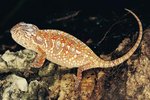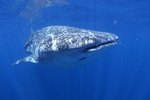
Lizards devote varying degrees of parental care to their offspring. Most species are oviparous, and deposit calcified eggs, while some are ovoviviparous, retaining their young internally, inside flexible, transparent shells that hatch near the time of parturition. Other lizards, called viviparous species, give live birth and use placenta-like connections with their young. Despite this variation, very few species provide care to their young once they are born or have hatched.
Selective Strategies
The amount of parental care lizards provide to their young varies from one species to the next. For some species, it is advantageous to protect their eggs or young, whereas other species are more successful letting their young care for themselves. Highly predatory species may be tempted to consume their young, whereas others must disperse in order to acquire sufficient resources. Some species -- especially some stump-tailed chameleons (Brookesia ssp.) -- may not even live long enough to care for their hatchlings, which emerge months after the parents have died.
Abandonment Issues
Most lizard species deposit their eggs in a secluded, thermally stable location; they bury them and leave forever. Most monitor lizards, geckos and agamids have evolved to abandon their eggs this way. Many of these species produce incredibly high numbers of offspring; though many fall victim to predators, starvation or disease, at least a few are likely to survive and pass on genes to the next generation.
Protective Parents
Some lizards do protect their eggs from predators. Five-lined skinks (Plestiodon fasciatus) are one such example. After the mother deposits about 10 eggs under a rock or inside a tree hollow, she curls around the egg mass until hatching time nears. Long-tailed skinks (Eutropis longicaudata) are also very protective of their eggs, and will even defend them from marauding snakes. Ovoviparity and viviparity are essentially extreme versions of this practice -- by keeping their young inside until they are ready to “hatch,” they not only protect them, but also accelerate their development by thermoregulating to keep them at optimal temperatures. Once the young hatch, they quickly disperse and receive no parental care.
Prehensile Parents
Prehensile-tailed skinks exhibit the most extreme example of parental care among lizards. These large, nocturnal lizards give birth to live young. Baby prehensile-tailed skinks remain with their parents for a period of six months to one year following their birth. During this time, both parents will actively defend the young from predators. The young also ingest feces from the adults -- this provides the young with beneficial intestinal bacteria that help them to digest their leaf-based diet.
References
- Sacramento Zoo: Prehensile-Tailed Skink
- Animal Diversity Web: Plestiodon Fasciatus
- James Cook University: Snakes Meet Their Match
- Evolution: The Evolution of Oviparity with Egg Guarding and Viviparity in Lizards and Snakes: A Phylogenetic Analysis
- Proceedings of the National Academy of Sciences of the United States of America: A Unique Life History Among Tetrapods: An Annual Chameleon Living Mostly as an Egg
Photo Credits
-
Photodisc/Photodisc/Getty Images



